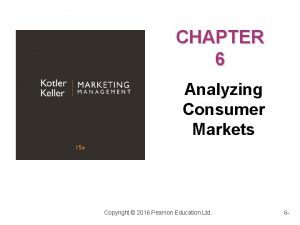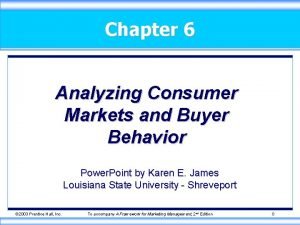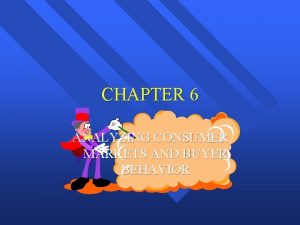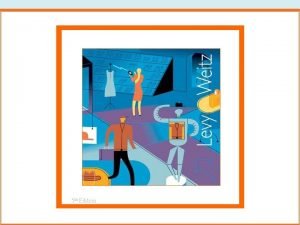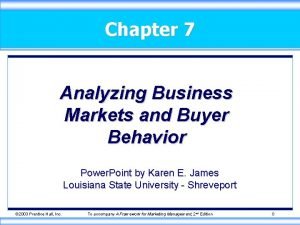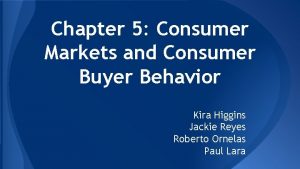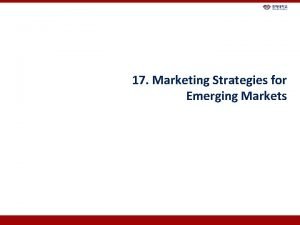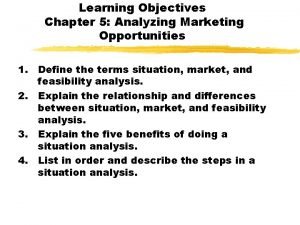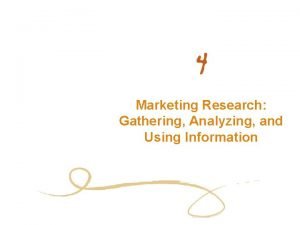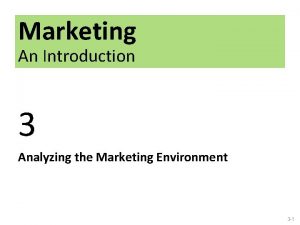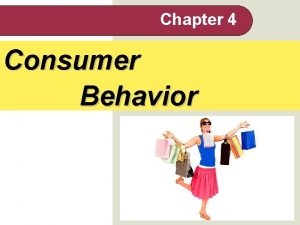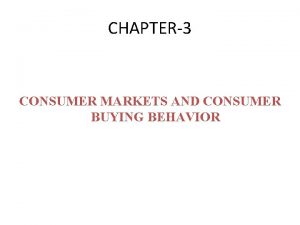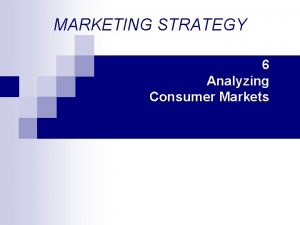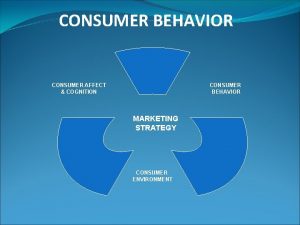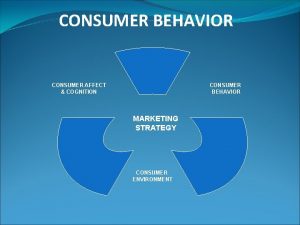6 Analyzing Consumer Markets Marketing Management 13 th

























- Slides: 25

6 Analyzing Consumer Markets Marketing Management, 13 th ed

Chapter Questions • How do consumer characteristics influence buying behavior? • What major psychological processes influence consumer responses to the marketing program? • How do consumers make purchasing decisions? • How do marketers analyze consumer decision making? Copyright © 2009 Pearson Education, Inc. Publishing as Prentice Hall 6 -2

What Influences Consumer Behavior? • Cultural factors • Social factors • Personal factors Copyright © 2009 Pearson Education, Inc. Publishing as Prentice Hall 6 -3

What is Culture? Culture is the fundamental determinant of a person’s wants and behaviors acquired through socialization processes with family and other key institutions. Copyright © 2009 Pearson Education, Inc. Publishing as Prentice Hall 6 -4

Subcultures • • Nationalities Religions Racial groups Geographic regions Copyright © 2009 Pearson Education, Inc. Publishing as Prentice Hall 6 -5

Fast Facts About American Culture • The average American: • • chews 300 sticks of gum a year goes to the movies 9 times a year takes 4 trips per year attends a sporting event 7 times each year Copyright © 2009 Pearson Education, Inc. Publishing as Prentice Hall 6 -6

Social Classes • • Upper uppers Lower uppers Upper middles Middle Working Upper lowers Lower lowers Copyright © 2009 Pearson Education, Inc. Publishing as Prentice Hall 6 -7

Characteristics of Social Classes • Within a class, people tend to behave alike • Social class conveys perceptions of inferior or superior position • Class may be indicated by a cluster of variables (occupation, income, wealth) • Class designation is mobile over time Copyright © 2009 Pearson Education, Inc. Publishing as Prentice Hall 6 -8

Social Factors • • Reference groups Family Social roles Statuses Copyright © 2009 Pearson Education, Inc. Publishing as Prentice Hall 6 -9

Reference Groups • • • Membership groups Primary groups Secondary groups Aspirational groups Disassociative groups Copyright © 2009 Pearson Education, Inc. Publishing as Prentice Hall 6 -10

Family Distinctions Affecting Buying Decisions • Family of Orientation • Family of Procreation Copyright © 2009 Pearson Education, Inc. Publishing as Prentice Hall 6 -11

Personal Factors • • Age Life cycle stage Occupation Wealth • • Personality Values Lifestyle Self-concept Copyright © 2009 Pearson Education, Inc. Publishing as Prentice Hall 6 -12

Brand Personality • • • Sincerity Excitement Competence Sophistication Ruggedness Copyright © 2009 Pearson Education, Inc. Publishing as Prentice Hall 6 -13

Lifestyle Influences • Multi-tasking • Time-starved • Money-constrained Copyright © 2009 Pearson Education, Inc. Publishing as Prentice Hall 6 -14

Table 6. 2 LOHAS (Lifestyles of Health and Sustainability) Market Segments • • • Sustainable Economy Healthy Lifestyles Ecological Lifestyles Alternative Health Care Personal Development Copyright © 2009 Pearson Education, Inc. Publishing as Prentice Hall 6 -15

Key Psychological Processes • • Motivation Perception Learning Memory Copyright © 2009 Pearson Education, Inc. Publishing as Prentice Hall 6 -16

Motivation Freud’s Theory Maslow’s Hierarchy of Needs Herzberg’s Two-Factor Theory Behavior is guided by subconscious motivations Behavior is driven by lowest, unmet need Behavior is guided by motivating and hygiene factors Copyright © 2009 Pearson Education, Inc. Publishing as Prentice Hall 6 -17

Maslow’s Hierarchy of Needs • • • Physiological needs Safety needs Social needs Esteem needs Self-actualization needs Copyright © 2009 Pearson Education, Inc. Publishing as Prentice Hall 6 -18

Perception • • Selective attention Selective retention Selective distortion Subliminal perception Copyright © 2009 Pearson Education, Inc. Publishing as Prentice Hall 6 -19

Figure 6. 4 Consumer Buying Process • • • Problem recognition Information search Evaluation Purchase decision Postpurchase behavior Copyright © 2009 Pearson Education, Inc. Publishing as Prentice Hall 6 -20

Sources of Information • • Personal Commercial Public Experiential Copyright © 2009 Pearson Education, Inc. Publishing as Prentice Hall 6 -21

Non-Compensatory Models of Choice • Conjunctive • Lexicographic • Elimination-by-aspects Copyright © 2009 Pearson Education, Inc. Publishing as Prentice Hall 6 -22

Perceived Risk • • • Functional Physical Financial Social Psychological Time Copyright © 2009 Pearson Education, Inc. Publishing as Prentice Hall 6 -23

Other Theories of Consumer Decision Making Involvement • Elaboration Likelihood Model • Low-involvement marketing strategies • Variety-seeking buying behavior Decision Heuristics • Availability • Representativeness • Anchoring and adjustment Copyright © 2009 Pearson Education, Inc. Publishing as Prentice Hall 6 -24

Mental Accounting • Consumers tend to… • • Segregate gains Integrate losses Integrate smaller losses with larger gains Segregate small gains from large losses Copyright © 2009 Pearson Education, Inc. Publishing as Prentice Hall 6 -25
 Chapter 6 consumer behavior
Chapter 6 consumer behavior Analyzing consumer markets ppt
Analyzing consumer markets ppt Changes in an individual's behavior arising from experience
Changes in an individual's behavior arising from experience Analyzing consumer markets
Analyzing consumer markets Analyzing consumer markets and buyer behavior
Analyzing consumer markets and buyer behavior The most basic determinant of a person's wants and behavior
The most basic determinant of a person's wants and behavior Analyzing consumer market
Analyzing consumer market Black box model consumer behaviour
Black box model consumer behaviour Analyzing consumer markets chapter 6
Analyzing consumer markets chapter 6 Retail marketing mix ppt
Retail marketing mix ppt Analyzing consumer and business markets
Analyzing consumer and business markets Analyzing consumer markets
Analyzing consumer markets Business buyer behavior refers to the
Business buyer behavior refers to the Food chain and web
Food chain and web Chapter 5 consumer markets and buyer behavior
Chapter 5 consumer markets and buyer behavior Analyzing consumer market
Analyzing consumer market Decomposer in the sahara desert
Decomposer in the sahara desert Consumer diversity in consumer behaviour
Consumer diversity in consumer behaviour Consumer research process
Consumer research process Marketing strategies for emerging markets
Marketing strategies for emerging markets Analyzing marketing opportunities
Analyzing marketing opportunities Analyzing the marketing environment summary
Analyzing the marketing environment summary Analyzing and using marketing information
Analyzing and using marketing information Managing marketing information to gain customer insights
Managing marketing information to gain customer insights The most dramatic force shaping our destiny is:
The most dramatic force shaping our destiny is: Companies who passively accept the marketing environment
Companies who passively accept the marketing environment
